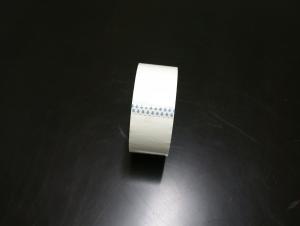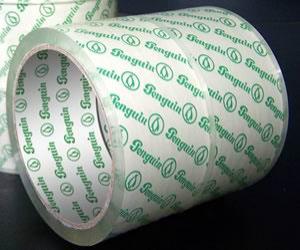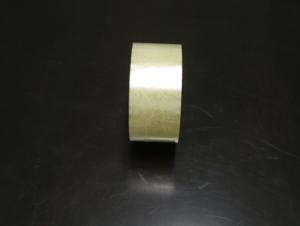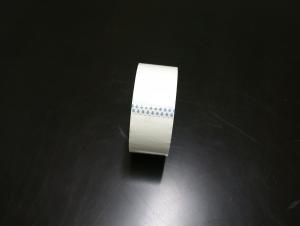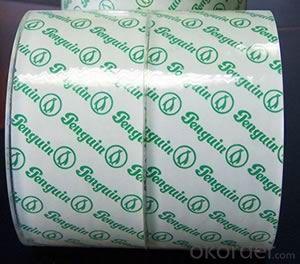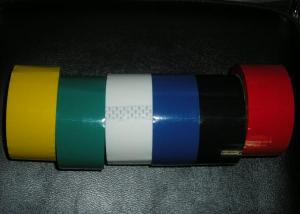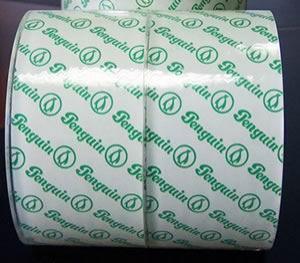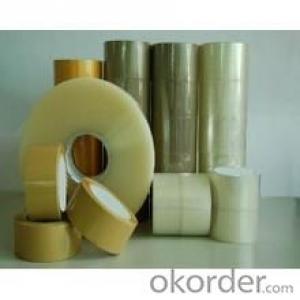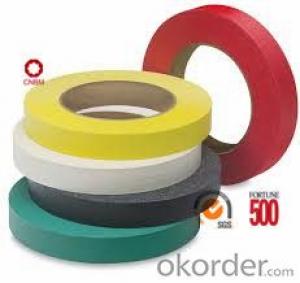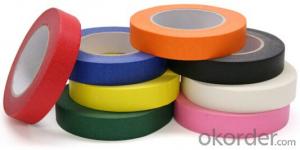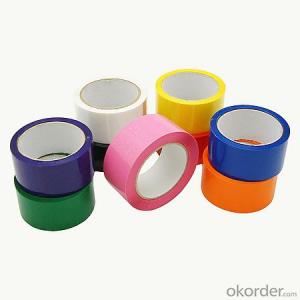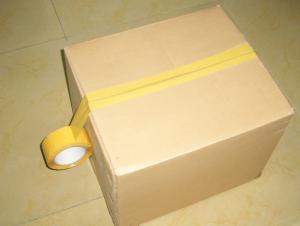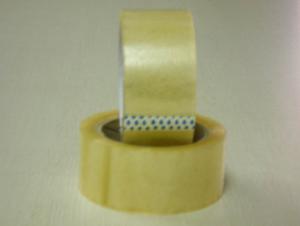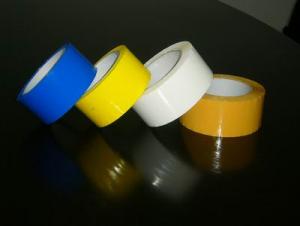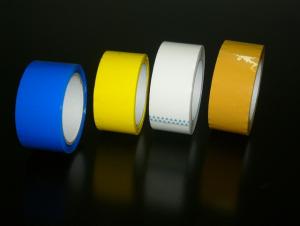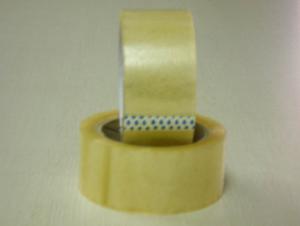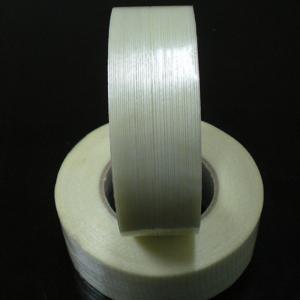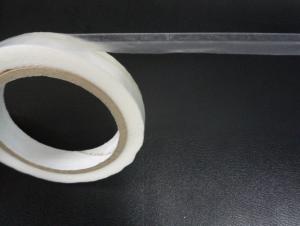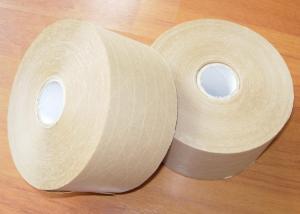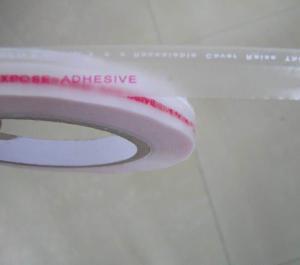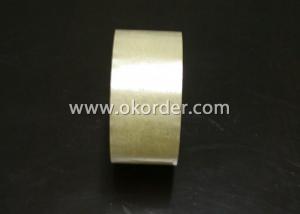BOPP Super Clear Packaging Tape Yards
- Loading Port:
- Shenzhen
- Payment Terms:
- TT
- Min Order Qty:
- 3000USD roll
- Supply Capability:
- 1x 20 ft roll/month
OKorder Service Pledge
OKorder Financial Service
You Might Also Like
Quick details:
Material: BOPP
Use: Carton Sealing
Adhesive Side: Single Sided
Adhesive: Acrylic
Adhesive Type: Water Activated
Design Printing: Offer Printing
Place of Origin: China (Mainland)
color: clear, super clear, crystal clear, red, blue, brown, yellow, green etc
Specifications:
| ItemNo. | Carrier | Adhesive | Total Thickness | Initial Tack | Peel Adhesion | Holding Power | Tensile Strength | Elongation |
| BP-40 | BOPP film | water based acrylic | 40 micron | >18# | 0.5kgf/25mm | >24h | >30N/cm | <180% |
| BP-45 | BOPP film | water based acrylic | 45 micron | >18# | 0.5kgf/25mm | >24h | >30N/cm | <180% |
| BP-50 | BOPP film | water based acrylic | 50 micron | >20# | 0.5kgf/25mm | >24h | >30N/cm | <180% |
| BP-65 | BOPP film | water based acrylic | 65 micron | >24# | 7.88N/25mm | >40h | >30N/cm | <180% |
Application:
Bopp tape is mainly for Carton sealing & packing, Light duty packaging, bundling, holding, and other office & household use.
Packing:
Paper Core ID: 76mm
Jumbo size: 0.99m x 1800m, 1.22m x 1800m, 1.51m x 1800m
Cut roll size: As per customer's requirement
Cut rolls: 6 rolls per shrink, 36/54/72 rolls per carton with or without pallet
Jumbo rolls & log rolls: Packed with kraft paper and stretch wrap film, with or without pallet
Company Advantages:
1. Stable financial status and sound reputation as a state invested corporation under the direct administration of the State Council of PRC;
2. CNBM’s world wide influence as one of the 500 global fortunes specializing in building materials including adhesive tapes;
3. More than a decade’s exporting experience and technology in adhesive tape industry;
4. Preferencial shipping channels, with a separate team dealing with shipping.
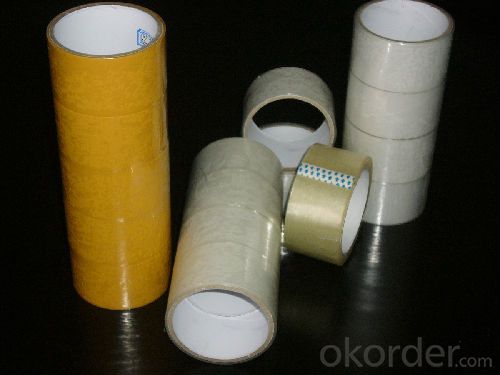
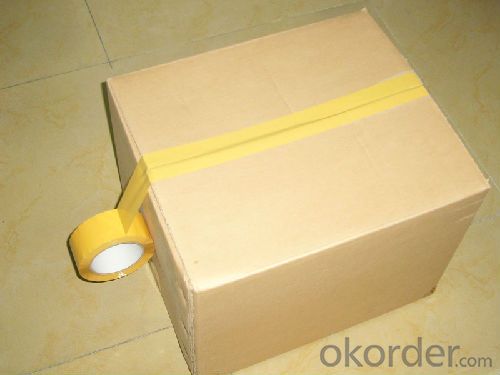
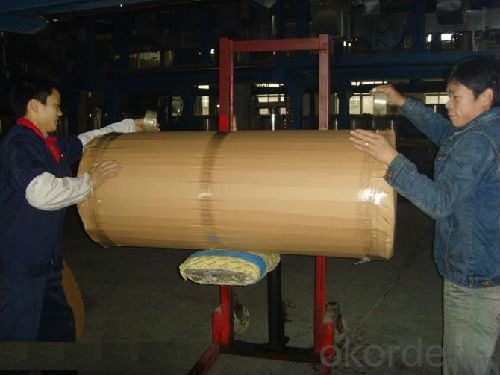
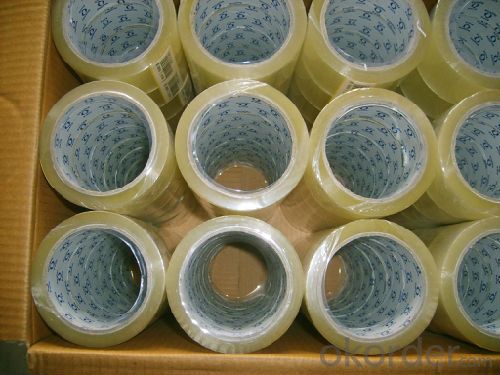
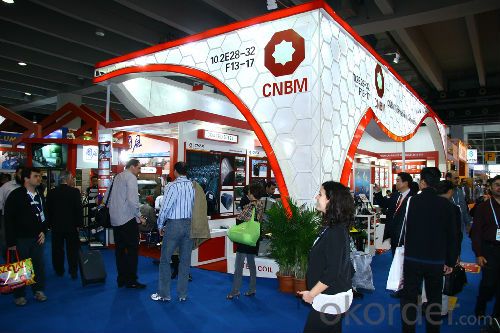
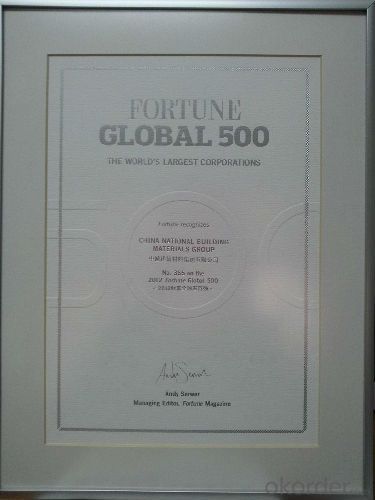
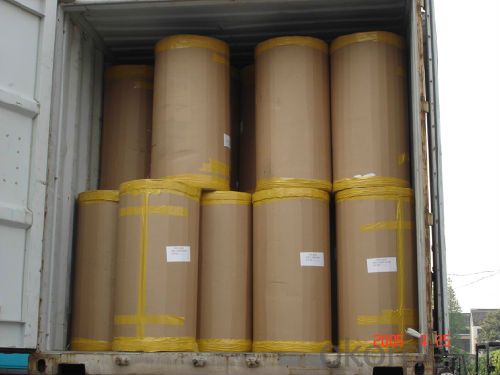
- Q: What is the difference between acrylic and hot melt adhesive for packaging tape?
- Packaging tape commonly utilizes two types of adhesives: acrylic and hot melt. These adhesives possess distinct characteristics that set them apart. A significant disparity lies in their bonding strength. Hot melt adhesive boasts exceptional bonding strength, making it ideal for heavy-duty applications. It creates a robust and durable bond that can withstand rigorous handling and varying temperatures. Conversely, acrylic adhesive typically offers a lower level of bonding strength in comparison. While still suitable for most general packaging requirements, it may not be the best choice for heavy or bulky items. Another distinction can be found in the application process. Hot melt adhesive is applied in a molten state and solidifies once cooled. Typically, it is dispensed using a hot melt glue gun or applicator. The quick setting time of hot melt adhesive allows for swift packaging operations, making it popular in high-volume settings. On the other hand, acrylic adhesive is applied in a liquid form and requires some time to cure and establish a strong bond. It can be applied using a hand dispenser or tape gun, and optimal adhesion often necessitates some pressure. Moreover, hot melt adhesive demonstrates excellent adhesion to a wide array of surfaces, including cardboard, plastics, and metals. Its versatility allows for usage with various packaging materials. While acrylic adhesive also adheres well to different surfaces, it may not exhibit the same level of compatibility with certain low-energy surfaces, such as polyethylene or polypropylene. Furthermore, temperature resistance is an essential factor to consider. Hot melt adhesive performs admirably in both high and low temperatures, maintaining its bonding strength. It can endure freezing temperatures and heat without compromising its adhesive properties. Acrylic adhesive, while generally offering good temperature resistance, may not be as effective in extreme conditions, particularly at very high or low temperatures. In conclusion, the primary disparities between acrylic and hot melt adhesives for packaging tape lie in bonding strength, the application process, surface compatibility, and temperature resistance. While hot melt adhesive provides superior bonding strength, rapid setting time, and excellent temperature resistance, acrylic adhesive offers versatility, ease of application, and good adhesion to most surfaces. The choice between the two depends on specific packaging needs, materials used, and environmental conditions.
- Q: Can packaging tape be used for securing shipments during transit?
- Yes, packaging tape can definitely be used for securing shipments during transit. Packaging tape is specifically designed to provide a strong and reliable seal for packages, ensuring that they remain intact and protected during transportation. It is commonly used for sealing cardboard boxes, securing bubble wrap or other protective materials around items, and reinforcing the closure of packages. Packaging tape is durable, easy to use, and provides a secure bond, making it an ideal choice for securing shipments during transit.
- Q: How many tapes do you need to make a tape? How do you calculate a mother roll and how many tapes do you make?To make a tape, you need a roll,1, how to calculate a mother roll, how many tapes do?2, now the mother rolls have what specifications?3. How much is the mother volume now?4, how do you calculate the profit of a roll of tape?
- 3. The mother rolls of different factories have different prices. You ask, that's how much beef is now. You don't know where to supply and where to sell4, that is, the price you sell, minus your cost price. This is a bit of a pupil's problem
- Q: What are the considerations for using packaging tape on textured surfaces?
- When using packaging tape on textured surfaces, there are a few considerations to keep in mind. Firstly, the texture of the surface can affect the adhesion of the tape. Textured surfaces typically have uneven or rough areas, which may make it difficult for the tape to adhere securely. It is important to choose a packaging tape that is specifically designed for textured surfaces. These tapes usually have a stronger adhesive that can better stick to uneven surfaces, ensuring that the tape will stay in place. Another consideration is the durability of the tape. Textured surfaces can be more abrasive than smooth surfaces, which can cause the tape to wear out more quickly. It is important to select a packaging tape that is made from a durable material, such as reinforced or heavy-duty tape. These types of tape are designed to withstand more wear and tear, providing a longer-lasting bond on textured surfaces. Additionally, the texture of the surface can also affect the appearance of the tape. Since textured surfaces are not smooth, the tape may not lay flat and can create air pockets or wrinkles. This can make the package look untidy or unprofessional. To improve the appearance, it may be necessary to use extra tape or apply it in a way that smooths out any unevenness. Lastly, it is important to consider the removal of the tape from textured surfaces. Textured surfaces can make it more difficult to remove the tape cleanly without leaving behind any residue. To prevent damage to the surface or any sticky residue, it is recommended to test the tape on a small, inconspicuous area before fully applying it. If the tape does leave residue, there are adhesive removers available that can help safely remove any remaining residue. In summary, when using packaging tape on textured surfaces, it is important to choose a tape specifically designed for uneven surfaces, select a durable tape that can withstand the texture, consider the appearance of the tape on the textured surface, and be cautious of any potential residue left behind when removing the tape.
- Q: Does packaging tape come in different widths for different applications?
- Yes, packaging tape does come in different widths for different applications. Packaging tape is available in various widths ranging from as small as 0.75 inches to as wide as 3 inches or even more. The choice of width depends on the specific application and the size of the package being sealed. Smaller widths are often used for lighter weight packages or for sealing small boxes or envelopes. On the other hand, wider widths are commonly used for heavy-duty or larger boxes that require extra strength and security. The availability of different widths allows users to select the most appropriate tape size based on their specific packaging needs.
- Q: Can packaging tape be used for sealing metal boxes?
- Indeed, metal boxes can be sealed using packaging tape. Specifically engineered to create a secure and long-lasting seal on different surfaces, such as metal, packaging tape possesses a powerful adhesive that effectively adheres to metal, guaranteeing that the box stays sealed throughout storage or transportation. Nevertheless, it is crucial to select a packaging tape appropriate for demanding tasks, capable of enduring the weight and pressure that the metal box may experience. Furthermore, it is advised to cleanse the metal surface prior to applying the tape to ensure optimal adhesion.
- Q: Can packaging tape be used for sealing vinyl flooring?
- No, packaging tape should not be used for sealing vinyl flooring. Vinyl flooring requires a specific type of adhesive designed for flooring applications. Using packaging tape may not provide the necessary durability and protection required for vinyl flooring. It is recommended to use a vinyl flooring adhesive or a compatible adhesive recommended by the manufacturer for the best results.
- Q: How wide is standard packaging tape?
- Standard packaging tape is typically 2 inches wide.
- Q: Is packaging tape safe to use on plastic outdoor furniture?
- Packaging tape is generally considered safe for use on plastic outdoor furniture. It is designed to adhere to different surfaces, including plastic. However, before using packaging tape on your outdoor furniture, it is important to take several factors into account. First and foremost, ensure that the plastic surface is clean and free of dirt or debris. This will enhance the tape's adhesion and prevent any harm to the furniture. Additionally, apply the tape evenly and firmly to avoid any peeling or lifting issues. It is crucial to remember that packaging tape is not specifically created for long-term outdoor use. Although it can be effective in temporarily securing items or protecting surfaces, it may not endure prolonged exposure to severe weather conditions or UV rays. Over time, the tape may deteriorate or leave sticky residue on the plastic furniture. If you require a more durable and weather-resistant solution, it is advisable to utilize specific outdoor adhesives or tapes specifically designed for this purpose. These products are typically made with materials that can withstand outdoor elements and are better suited for long-term use on plastic outdoor furniture.
- Q: Can packaging tape be used for sealing medical or laboratory containers?
- Packaging tape is not recommended for sealing medical or laboratory containers. While packaging tape may provide a temporary seal for general packaging purposes, it is not designed or tested to meet the specific requirements of medical or laboratory environments. Medical and laboratory containers often require specialized sealing methods to ensure airtight and sterile conditions, as well as to prevent contamination or tampering. These containers typically use specialized seals, such as adhesive strips, rubber gaskets, or screw caps, that are specifically designed to meet the stringent requirements of medical or laboratory applications. Therefore, it is crucial to use the appropriate sealing methods and materials recommended by the manufacturer or industry standards to ensure the integrity and safety of medical or laboratory containers.
1. Manufacturer Overview
| Location | Fujian, China |
| Year Established | 1994 |
| Annual Output Value | Above US$ 1000 Million |
| Main Markets | Southeast Asia; South America; Eastern Europe; North America; Northern Europe; South Asia; Western Europe; Africa; Mid East |
| Company Certifications |
2. Manufacturer Certificates
| a) Certification Name | |
| Range | |
| Reference | |
| Validity Period |
3. Manufacturer Capability
| a) Trade Capacity | |
| Nearest Port | Shenzhen |
| Export Percentage | 41% - 50% |
| No.of Employees in Trade Department | 101-200 People |
| Language Spoken: | English; Chinese |
| b) Factory Information | |
| Factory Size: | Above 10,000 square meters |
| No. of Production Lines | Above 10 |
| Contract Manufacturing | produce single sided tapes,double sided tapes, masking tape, Opp tape |
| Product Price Range | Low; Average |
Send your message to us
BOPP Super Clear Packaging Tape Yards
- Loading Port:
- Shenzhen
- Payment Terms:
- TT
- Min Order Qty:
- 3000USD roll
- Supply Capability:
- 1x 20 ft roll/month
OKorder Service Pledge
OKorder Financial Service
Similar products
Hot products
Hot Searches
Related keywords
